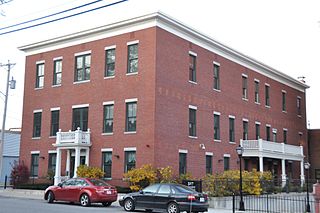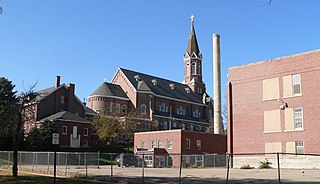
The Ursulines, also known as the Order of Saint Ursula, is an enclosed religious order of consecrated women that branched off from the Angelines, also known as the Company of Saint Ursula, in 1572. Like the Angelines, they trace their origins to their foundress Saint Angela Merici and place themselves under the patronage of Saint Ursula. While the Ursulines took up a monastic way of life under the Rule of Saint Augustine, the Angelines operate as a secular institute. The largest group within the Ursulines is the Ursulines of the Roman Union.

Katharine Drexel was an American heiress, philanthropist, religious sister, educator, and founder. She was canonized by the Roman Catholic Church in 2000; her feast day is celebrated on March 3. She was the second American to be canonized a saint and the first one born a U.S. citizen. She was inducted into the National Women's Hall of Fame in 2011.

Mells is a village and civil parish in Somerset, England, near the town of Frome.

Saint Mary's Abbey in Colwich, Staffordshire was a monastery of Roman Catholic nuns of the English Benedictine Congregation, founded in 1623 at Cambrai, Flanders, in the Spanish Netherlands, and closed down in 2020. During the French Revolution, the community was expelled from France and settled at The Mount, Colwich, in 1836, where it remained for the next 84 years.

St. Mary's Complex is a historic Roman Catholic Church complex at Broadway and Washington Street in Taunton, Massachusetts. The parish, the first in Taunton, was established in 1830, and the present church, its second was built in 1868, to a design by Patrick C. Keely. The complex, also including a rectory, convent, and school, was listed on the National Register of Historic Places in 1984.

St. Joseph's Convent and School is a historic convent and school at 517 Moody Street in Lowell, Massachusetts. The school is a three-story brick building built in 1883. Its Italianate styling includes an extended wooden cornice decorated with brackets. The convent, built in 1911, is a modestly-ornmanented Colonial Revival three story brick building. Most of the interiors of the buildings were significantly altered over the course of the 20th century, losing most of their historical integrity; however, a 2001 rehabilitation has reintroduced interior styling in keeping with the age and style of the buildings.

St. Mary's Catholic Church, also known as St. Mary of the Visitation Church, is a parish church of the Diocese of Davenport which is located in Iowa City, Iowa, United States. The church building and rectory were listed together on the National Register of Historic Places in 1980. They were both included as contributing properties in the Jefferson Street Historic District in 2004. The parish's first rectory, which is now a private home, is also listed on the National Register as St. Mary's Rectory. It is located a few blocks to the east of the present church location at 610 E. Jefferson St.

St. Mary's Catholic Church is a parish church of the Diocese of Davenport. The church is located at the corner of St. Mary's and Washburn Streets in the town of Riverside, Iowa, United States. The entire parish complex forms an historic district listed on the National Register of Historic Places as St. Mary's Parish Church Buildings. The designation includes the church building, rectory, the former church, and former school building. The former convent, which was included in the historical designation, is no longer in existence.

Holy Family Catholic Church is a parish of the Diocese of Davenport. The parish is the result of a merger between Saints Mary and Joseph Parish and Sacred Heart Parish in the city of Fort Madison, Iowa, United States. It maintains both of the former parish church buildings as worship sites. The oldest parish in town, St. Joseph, and St. Mary of the Assumption had merged in the 1990s. St. Mary of the Assumption Church, which became Saints Mary and Joseph, is located at 11th Street and Avenue E. It was individually listed on the National Register of Historic Places in 1980. Sacred Heart Church is located at 23rd Street and Ave I.

The Nativity of the Blessed Virgin Mary Catholic Church is a historic Catholic church in Cassella, an unincorporated community in Mercer County, Ohio, United States. One of several Catholic churches in Marion Township, it has been designated a historic site because of its well-preserved nineteenth-century architecture.

St. Mary's Catholic Church is a parish of the Archdiocese of Dubuque. The church is located in Guttenberg, Iowa, United States. It is listed on the National Register of Historic Places as St. Mary's Catholic Church Historic District. In addition to the church, the historic district includes the parish rectory, convent, and school building.

St. Boniface Catholic Church is a parish of the Diocese of Sioux City. The church is located in a residential area west of downtown Sioux City, Iowa, United States. The parish buildings form a nationally recognized historic district that was listed on the National Register of Historic Places in 1998 as St. Boniface Historic District. At the time of its nomination it contained three resources, all of them contributing buildings.

The Church of St Mary of the Assumption is in Yorkshire Street, Burnley, Lancashire, England. It is an active Roman Catholic parish church in the diocese of Salford. The church is recorded in the National Heritage List for England as a designated Grade II listed building. It was built between 1846 and 1849 to replace a smaller chapel on a different site. The church was designed by Weightman and Hadfield in Decorated style, and a chapel was added to it in 1879.

The Masonic Hall in Taunton, Somerset, is designated by Historic England as a Grade II* listed building. It was originally built in the early 19th century as St George's Chapel, the first Roman Catholic chapel open for public worship in Taunton since the Reformation. The building, which forms the end of a terrace, features a series of prominent Ionic pilasters along the front and southern end.

The Church of St George is a Roman Catholic church in Taunton, Somerset, which dates from the mid-19th century. It was the second Catholic church to be built in Taunton after the Reformation, replacing the much smaller St George's Chapel. The main church building is designated by Historic England as a Grade II* listed building, while the rectory is Grade II listed.

The Crescent is a street in Taunton, a town in the English county of Somerset. Construction began in 1807, during a period of extensive redevelopment in the town, driven by the Market House Society and the Member of Parliament Sir Benjamin Hammet. Lined on the eastern side by a Georgian terrace, the street follows a shallow crescent shape, broken in the middle by Crescent Way and a bit further south by St George's Place. It links Upper High Street, at its southern end, with Park Street and Tower Street to the north. On the western side, Somerset County Council have their offices in the County Hall, erected in 1935, and extended in the 1960s. The Georgian terrace, the Masonic Hall, and the County Hall are recorded in the National Heritage List for England as listed buildings.

The St. Joseph's Church Complex is a collection of historic buildings located in Fort Madison, Iowa, United States. At one time the complex housed a Catholic parish in the Diocese of Davenport. St. Joseph and St. Mary of the Assumption parishes merged in the 1990s to form Saints Mary and Joseph Parish. In 2007 when that parish merged with Sacred Heart on the west side to form Holy Family Parish, St. Joseph's Church was closed. The former church, chapel, rectory, convent, and school were included as contributing properties in the Park-to-Park Residential Historic District that was listed on the National Register of Historic Places in 2014.

The St. Hyacinth School and Convent are a pair of religious and educational buildings at 2 Walker Street in Westbrook, Maine. The school, built in 1894, is a fine local example of Second Empire design, and the 1922 convent is a good example of Gothic Revival architecture. Both were built by the local Roman Catholic parish of St. Hyacinth to support the burgeoning French-Canadian and French-American community, many of whom worked in the local mills. The buildings were listed on the National Register of Historic Places in 2013. Both have been converted into residential housing.
Thomas Doyle D.D. (1793–1879) was an English Roman Catholic priest, associated with the construction of St George's Cathedral, Southwark.

Saints Mary and Joseph Catholic Cathedral is a heritage-listed cathedral at 132 Dangar Street, Armidale, Armidale Regional Council, New South Wales, Australia. It is the diocesan cathedral of the Roman Catholic Diocese of Armidale and the seat of the Catholic Bishop of Armidale. The cathedral was designed by John Hennessy of Sheerin and Hennessy, and built from 1911 to 1912 by George Frederick Nott. It is also known as the St Mary & St Joseph Catholic Cathedral and the Cathedral of Saint Mary and Saint Joseph. It was added to the New South Wales State Heritage Register on 13 February 2015.





















